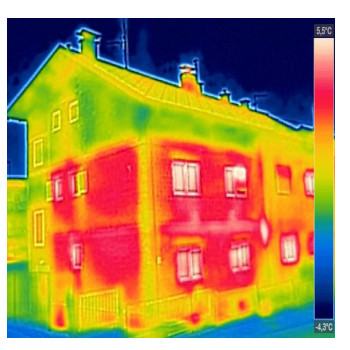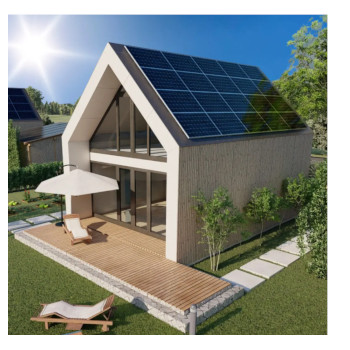
WHAT IS THE FUTURE OF BUILDING INSULATION?*
The world is changing rapidly. With the increasing pace of development, we are populating the Earth, consequently producing more CO2. As a result, we are raising the Earth's temperature. We hear about temperature records more and more often, reaching 51 °C. This raises the question of whether insulation will be needed at all. In this article, we will address whether insulation will be necessary in 50 years, whether it makes sense to invest in home insulation, and what if there are no more cold winters.
THE FUTURE IMPACT OF HIGH TEMPERATURES ON HOME INSULATION
 United Kingdom is not known for severe winters; the coldest temperatures recorded in England have reached as low as -23°C. However, such temperatures are relatively rare and typically last for a short period, often just 2-3 days. In general, the temperatures in the UK during winter mostly range from 2-5°C.
United Kingdom is not known for severe winters; the coldest temperatures recorded in England have reached as low as -23°C. However, such temperatures are relatively rare and typically last for a short period, often just 2-3 days. In general, the temperatures in the UK during winter mostly range from 2-5°C.
Even with these relatively mild winter temperatures, insulation is still necessary to ensure comfort indoors. But what if the average winter temperature were to rise to 10°C?
A temperature of 10°C is the threshold at which gas heating systems typically switch to summer mode, turning off radiators. How far are we from such a temperature?
Some might think that it's doubtful, but in about 400 years, According to Bulletin of Atomic Scientists Earth's temperatures could get really, really hot. This could lead to water shortages because of droughts and more frequent wildfires. In that case, we'd still need insulation for our homes, but not to keep them warm in winter. Instead, it would be to keep them cool from the scorching sun.
So, no matter what happens, insulation will still be important to keep our homes comfortable. Maybe materials like rock wool, which doesn't catch fire, will be super important for protecting our homes from fires.
THE FUTURE OF HOME INSULATION IN THE UK: WHY ARE HOMES POORLY INSULATED?
 Many homes in the UK lack proper insulation because they were constructed before modern insulation standards were established. The winters in the UK have historically been relatively mild, and heating homes used to be quite affordable. The cost of living was low, so most people didn't see the need to insulate their homes.
Many homes in the UK lack proper insulation because they were constructed before modern insulation standards were established. The winters in the UK have historically been relatively mild, and heating homes used to be quite affordable. The cost of living was low, so most people didn't see the need to insulate their homes.
Additionally, many homes in the UK are subject to regulations that safeguard their historical character and prohibit structural changes.
This has presented difficulties when attempting to install insulation in these older buildings.
As the cost of living in the UK increased, people started looking for ways to save money. Today, on average, British households spend between £800 and £1,500 annually on gas bills. This has prompted homeowners to consider insulation as a necessary investment to reduce energy costs.
WILL WE NEED INSULATION IN THE FUTURE?
Considering the high likelihood of experiencing extreme temperatures in summer and winter, it can be argued that insulation will continue to be a necessity in the future, but primarily for cooling rather than heating. This is quite plausible, especially when considering the relatively low impact on CO2 emissions in highly developed European countries. To put this into perspective, Europe as a continent accounted for 14% of global CO2 emissions in 2019. The majority of other continents do not have immediate plans for CO2 reduction, increasing the likelihood of future temperature extremes, which accounts for 86%.
On the other hand, in the future, warmer winters might mean lower heating bills for people. But the concern is whether they'll end up spending more on air conditioning during hotter summers instead.
Regardless of what happens with future temperatures on Earth, we will still need insulation, whether it's to keep the cold out or to stay cool in the heat. Considering the other investments we make in our homes, investing in insulation makes a lot of sense and is quite rational, especially since it leads to significant savings over many years. Therefore, let's view the investment in home insulation as a wise decision for the future, like catching the last train before it leaves the station.
WHAT ARE THE FUTURE MATERIALS FOR INSULATION?
In the future, insulation materials are likely to be predominantly thin. Why do we make this prediction? Well, it's interesting to note that 7 out of 20 customers at our insulation store ask for the thinnest insulation options, and 3 out of 10 customers come back to purchase the same product again. We believe, this trend is closely related to the increasing cost of real estate, where every millimetre is incredibly valuable. Insulating our homes not only impacts our wallets but also the available space within our homes.
That's why insulation of the future is likely to involve products like 10mm options such as Aerogel, used in spaceship, or 15mm foam insulation. There is also a growing discussion about future insulation materials like insulating paints, insulating wallpapers (such as 10mm Sempatap), and thin insulating renders. One thing is certain, insulation technology for homes is headed in this direction.
IS INSULATION A GOOD INVESTMENT FOR THE FUTURE?
Imagine you own two houses, one in Spain for the winter and one in the UK for the summer. You're able to switch between them because you work online from home. But what about those who can't move freely? Their jobs tie them down to one location. While we can handle the heat in the UK for now, in 50 years, Spain might become unbearably hot, with temperatures reaching around 40°C, which is higher than our body temperature of 36.6°C. So, should we consider investing in better insulation, and is it something we truly need?
Well, yes. Insulating your home now makes sense for a few reasons. Building materials are getting more expensive, and the cost of installing insulation is adding about 50% to their price.
For example, if you buy the thickest insulation available today (165mm Unilin PIR), in about 10 years, you'll only get a thinner one for the same money (100mm Unilin PIR).
The cost of materials is going up not only due to increasing prices but also because it's becoming pricier to produce these materials. According to statista.com
’The prices of acoustic and thermal insulating materials significantly increased between 2017 and 2022. In 2022, the prices of the insulating materials were around 66 percent higher than in 2015’
In conclusion, if you purchase thick insulation today (such as 165mm Unilin PIR), in about a decade, you'll likely only get a thinner one for the same price due to these rising costs of materials and production. Therefore, taking action now to improve your home's insulation can save you money and make your living environment more comfortable in the long run.
WILL BUILDINGS IN THE FUTURE BE SELF-SUFFICIENT?
 This is a question that doesn't have a definitive answer, but many signs point to the possibility becoming more and more real.
This is a question that doesn't have a definitive answer, but many signs point to the possibility becoming more and more real.
Self-sufficient homes are those that, thanks to advanced technologies, can function without relying on external sources of energy such as gas, electricity, or hot water. Renewable energy sources like solar panels and heat pumps are used to power these buildings. They can produce their own heat and electricity while also being independent of water and sewage systems.
Currently, it appears that buildings in the future will lean towards self-sufficiency.
Modern passive houses equipped with advanced thermal insulation and air recovery systems are steps in this direction. However, in some countries like the United Kingdom, there is a challenge related to gas dependency, as the extensive gas infrastructure makes it difficult to introduce alternative heating sources. For instance, heat pumps often require three-phase electricity, which is not standard in many homes.
CONCLUSION
Advancing technology and growing environmental awareness provide hope that future buildings will be increasingly self-sufficient and environmentally friendly.
Advancements in materials and technologies, such as aerogels offer the potential for highly efficient insulation with minimal environmental impact. Additionally, the growing emphasis on green building standards and energy-efficient construction practices will further drive the demand for cutting-edge insulation solutions.
In the coming years, we can expect to see a shift towards not only improving the thermal performance of insulation but also addressing other critical factors like fire resistance, acoustic insulation, and sustainability. As homeowners, builders, and policymakers increasingly prioritise energy conservation and environmental responsibility, the insulation industry will need to adapt and innovate to meet these evolving needs.
Ultimately, the future of building insulation is bright, with the potential to significantly reduce energy consumption, and create healthier, more comfortable indoor spaces. As technology continues to advance and environmental consciousness grows, we can look forward to a future where our buildings are not only well-insulated but also more sustainable and resilient in the face of a changing climate.
RELATED ARTICLES:
INSULATION COST COMPARISON: EPS vs PIR vs MINERAL WOOL
SMART THERMAL INSULATION THAT'S CHANGING THE GAME.
THE PRICE OF COMFORT: UNRAVELLING WHY INSULATION IS SO EXPENSIVE
WHAT TO CONSIDER WHEN CHOOSING INSULATION MATERIALS
THE RISKY TERRITORY OF BUYING AN UNINSULATED HOME: DOES IT MAKE SENSE?
COMPARING ALTERNATIVES TO CELOTEX: ROCKWOOL, KINGSPAN, EPS, AND XPS POLYSTYRENE
INSULATION BUILDING REGULATIONS IN THE UK: A COMPREHENSIVE GUIDE
BIBLIOGRAPHY:
Pictures credit:https://thebulletin.org,well.pl,energialehome.com
1.thebulletin.org, Dawn Stover, ‘Global heat wave: an epic TV news fail’, blog, 19 July 2019, accessed September 20, 2023.
2.statista.com, Statista Research Department,‘Acoustic and thermal insulating materials price index in the United Kingdom (UK) from 2017 to 2022’, July 20 , 2022, accessed September 20, 2023.
*All the information provided in the content published on Insulationgo blog is for informational and educational purposes only. Insulationgo LTD makes every effort to ensure the accuracy and timeliness of the content, but we do not assume any responsibility for any errors or omissions.
The information presented on this blog should not be considered as professional advice or a substitute for consulting relevant experts. Before making any purchase decisions or taking action based on the information presented here, it is strongly recommended to contact the product manufacturer directly to verify the details and ensure its suitability for your specific needs.
Any descriptions, drawings, photographs, data, proportions, weights, measured values etc. given herein may change without prior notice and do not constitute the agreed contractual quality of the products. It is the responsibility of the recipient of all products to ensure that any proprietary rights and existing laws and legislation are observed.
By using this blog, you acknowledge and agree that Insulationgo LTD shall not be held liable for any damages, losses, or inconveniences arising from the use or reliance on the information provided herein. This limitation of liability applies to all users of the blog, including but not limited to visitors, readers, and subscribers.










































































































